Mechanical Model for Calculating Surface Movement Related to Open-Pit and Underground Caving Combined Mining
Abstract
:1. Introduction
2. Engineering Background
3. Characteristics and Angle of Rock Movement
4. Establishment of the Mechanical Model
5. The Solution of the Mechanical Model
5.1. Coordinate Transformation
5.2. Piecewise Solution
5.2.1. Solving the First Part (xF1 ≤ x1 ≤ xC1)
5.2.2. Solving the Second Part (xD1 ≤ x1 < xF1)
5.2.3. Solving the Third Part (0 ≤ x1 < xD1)
6. The Solution of the Subsidence Angle
6.1. Supplementary Definition and Calculation Method of the Subsidence Angle
6.2. Calculation Result of the Subsidence Angle
7. Analysis of On-Site Monitoring Data
8. Conclusions
- (1)
- Taking the combined mining of the Dahongshan Iron Mine as an example, a mechanical model for calculating the surface movement range was established according to the zoning characteristics of surface movement to reveal the movement mechanism. The change in topography caused by open-pit mining, the shape of the caving zone, the gravel filling of the caving zone and the mining depth were considered in the model.
- (2)
- Based on the mechanical model, the definition of the subsidence angle was supplemented: the subsidence angle is the angle measured from the horizontal of the moving boundary line, a straight line with zero displacement from the edge of the deepest extraction level to the surface and the largest surface cracking range.
- (3)
- According to the supplementary definition of the subsidence angle, a trial calculation method for calculating the subsidence angle was proposed: by presetting different subsidence angles, the subsidence angle corresponding to the maximum surface prone cracking range calculated by mechanical model can be found as the real subsidence angle.
- (4)
- The subsidence angle calculated by the mechanical model was 60°, consistent with the observed subsidence angle of 64° in Dahongshan Iron Mine. The mechanical model provides a new method for calculating the surface movement range for metal mines used for open-pit and underground caving combined mining.
Author Contributions
Funding
Data Availability Statement
Conflicts of Interest
References
- Zhao, X.D.; Li, L.C.; Tang, C.A.; Zhang, H.X. Stability of boundary pillars in transition from open pit to underground mining. J. Cent. South Univ. 2012, 19, 3256–3265. [Google Scholar] [CrossRef]
- Afum, B.O.; Ben-Awuah, E.; Askari-Nasab, H. A mixed integer linear programming framework for optimising the extraction strategy of open pit—Underground mining options and transitions. Int. J. Min. Reclam. Environ. 2019, 34, 700–724. [Google Scholar] [CrossRef]
- Ren, F.Y.; Sow, T.A.M.; He, R.X.; Liu, X.R. Optimization and application of blasting parameters based on the “pushing-wall” mechanism. Int. J. Miner. Metall. Mater. 2012, 19, 879–885. [Google Scholar] [CrossRef]
- Elantseva, L.A.; Fomenko, S.V. Drainage Efficiency Enhancement for Watered Sludge in Aikhal Open Pit Mine. J. Min. Sci. 2021, 57, 249–255. [Google Scholar] [CrossRef]
- Bakhtavar, E.; Shahriar, K.; Mirhassani, A. Optimization of the transition from open-pit to underground operation in combined mining using (0-1) integer programming. J. South Afr. Inst. Min. Metall. 2012, 112, 1059–1064. [Google Scholar]
- Fan, X.M.; Ren, F.Y.; Xiao, D.; Mao, Y.C. Opencast to underground iron ore mining method. J. Cent. South Univ. 2018, 25, 1813–1824. [Google Scholar] [CrossRef]
- Chen, J.H.; Gu, D.S.; Li, J.X. Optimization principle of combined surface and underground mining and its applications. J. Cent. South Univ. Technol. 2003, 10, 222–225. [Google Scholar] [CrossRef]
- Reza, B.A.; Vojtech, G. 3D numerical parametric study of the influence of open-pit mining sequence on existing tunnels. Int. J. Min. Sci. Technol. 2017, 27, 459–466. [Google Scholar] [CrossRef]
- MacNeil, J.A.L.; Dimitrakopoulos, R.G. A stochastic optimization formulation for the transition from open pit to underground mining. Optim. Eng. 2017, 18, 793–813. [Google Scholar] [CrossRef]
- Epstein, R.; Goic, M.; Weintraub, A.; Catalan, J.; Santibanez, P.; Urrutia, R.; Cancino, R.; Gaete, S.; Aguayo, A.; Caro, F. Optimizing Long-Term Production Plans in Underground and Open-Pit Copper Mines. Oper. Res. 2012, 60, 4–17. [Google Scholar] [CrossRef]
- Zhao, Y.; Yang, T.H.; Bohnhoff, M.; Zhang, P.H.; Yu, Q.L.; Zhou, J.R.; Liu, F.Y. Study of the rock mass failure process and mechanisms during the transformation from open-pit to underground mining based on microseismic monitoring. Rock. Mech. Rock. Eng. 2018, 51, 1473–1493. [Google Scholar] [CrossRef]
- Zhao, Y.; Yang, T.H.; Yu, Q.L.; Zhang, P.H. Dynamic reduction of rock mass mechanical parameters based on numerical simulation and microseismic data—A case study. Tunn. Undergr. Space Technol. 2019, 83, 437–451. [Google Scholar] [CrossRef]
- He, R.X.; Fu, Y.; Ren, F.Y.; Song, D.L.; Liu, Y.; Tan, B.H. Strata movement law of subsequent mining of collapse pit in southeast mining area of Gongchangling iron mine. J. Mining. Saf. Eng. 2019, 36, 527–534. (In Chinese) [Google Scholar]
- Li, S.L.; Hu, J.Y.; Zhou, A.M.; Lin, F.; Yu, Z.F. Comprehensive research on character of collapse and fracture of thick and large overburden rock in cave mining. Chin. J. Rock Mech. Eng. 2016, 35, 1729–1739. (In Chinese) [Google Scholar]
- Ministry of Emergency Management, PRC. Safety Regulation for Metal and Nonmetal Mines (GB 16423-2020); Emergency Management Press: Beijing, China, 2020. (In Chinese)
- Cheng, G.W.; Yang, T.H.; Liu, H.Y.; Wei, L.K.; Zhao, Y.; Liu, Y.L.; Qian, J.W. Characteristics of stratum movement induced by downward longwall mining activities in middle-distance multi-seam. Int. J. Rock. Mech. Min. Sci. 2020, 136, 104517. [Google Scholar] [CrossRef]
- Song, Z.Q. Utility Mine Pressure and Control; China University of mining and Technology Press: Xuzhou, China, 1988. (In Chinese) [Google Scholar]
- Ju, J.F.; Xu, J.L. Structural characteristics of key strata and strata behaviour of a fully mechanized longwall face with 7.0 m height chocks. Int. J. Rock. Mech. Min. Sci. 2013, 58, 46–54. [Google Scholar] [CrossRef]
- Yin, L.M.; Ma, K.; Chen, J.T.; Xue, Y.C.; Wang, Z.Q.; Cui, B.Q. Mechanical model on water inrush assessment related to deep mining above multiple aquifers. Mine. Water. Environ. 2019, 38, 827–836. [Google Scholar] [CrossRef]
- Ma, K.; Yang, T.H.; Deng, W.X.; Hou, X.G.; Li, Z.S.; Zhao, Y.; Liu, Y.L.; Gao, Y.; Sun, D.D.; Hou, J.X. Analysis of water inrush at Dongyu coal mine in China from an old water-logged goaf associated with a syncline fractured zone. Hydrogeol. J. 2023, 31, 417–433. [Google Scholar] [CrossRef]
- Castro, R.; Lopez, S.; Gomez, R.; Ortiz, S.; Carreno, N. Experimental study of the influence of drawbell geometry on hang-ups in cave mine applications. Rock. Mech. Rock. Eng. 2020, 54, 1–10. [Google Scholar] [CrossRef]
- Brady, B.H.G.; Brown, E.T.D. Rock Mechanics for Underground Mine; George Allen Unwin: London, UK, 1985. [Google Scholar]
- Zhen, J.M.; Ren, F.Y.; Tang, L.X. Critical depth prediction and surface subsidence range controlling based on Xishimen mine. J. Min. Saf. Eng. 2014, 31, 631–634. (In Chinese) [Google Scholar]
- Hoek, E. Progressive caving induced by mining an inclined orebody. Trans. Instn. Min. Metall. 1974, 83, A133–A139. [Google Scholar]
- Villegas, T.; Nordlund, E.; Dahner-Lindqvist, C. Hangingwall surface subsidence at the Kiirunavaara Mine, Sweden. Eng. Geol. 2011, 121, 18–27. [Google Scholar] [CrossRef]
- Ma, K.; Yang, T.H.; Zhao, Y.; Hou, X.G.; Liu, Y.L.; Hou, J.X.; Zheng, W.X.; Ye, Q. Mechanical model for analyzing the water-resisting key stratum to evaluate water inrush from goaf in roof. Geomech. Eng. 2022, 28, 299–311. [Google Scholar] [CrossRef]
- Li, L.C.; Tang, C.A.; Zhao, X.D.; Cai, M. Block caving-induced strata movement and associated surface subsidence: A numerical study based on a demonstration model. Bull. Eng. Geol. Environ. 2014, 73, 1165–1182. [Google Scholar] [CrossRef]
- Zhang, D.J.; Wang, J.D.; Guo, S.; Cao, J.L. Numerical simulation of crack evolution mechanism and subsidence characteristics effected by rock mass structure in block caving mining. Geotech. Geol. Eng. 2022, 40, 5377–5395. [Google Scholar] [CrossRef]
- Parmar, H.; Bafghi, A.Y.; Najafi, M. Impact of ground surface subsidence due to underground mining on surface infrastructure: The case of the Anomaly No. 12 Sechahun, Iran. Environ. Earth. Sci. 2019, 78, 409. [Google Scholar] [CrossRef]
- Takhanov, D.; Muratuly, B.; Rashid, Z.; Kydrashov, A. Geomechanics substantiation of pillars development parameters in case of combined mining the contiguous steep ore bodies. Min. Min. Dep. 2021, 15, 50–58. [Google Scholar] [CrossRef]
- Imashev, A.; Suimbayeva, A.; Zhunusbekova, G.; Zeitinova, S.; Kuttybayev, A.; Mussin, A. Research into stress-strain state of the mass under open pit with a change in the open-pit bottom width. Min. Min. Dep. 2022, 16, 61–66. [Google Scholar] [CrossRef]
- Ghazdali, O.; Moustadraf, J.; Tagma, T.; Alabjah, B.; Amraoui, F. Study and evaluation of the stability of underground mining method used in shallow-dip vein deposits hosted in poor quality rock. Min. Min. Dep. 2021, 15, 31–38. [Google Scholar] [CrossRef]
- Woo, K.S.; Eberhardt, E.; Elmo, D.; Stead, D. Empirical investigation and characterization of surface subsidence related to block cave mining. Int. J. Rock. Mech. Min. Sci. 2013, 61, 31–42. [Google Scholar] [CrossRef]
- Bruneau, G.; Hudyma, M.R.; Hadjigeorgiou, J.; Potvin, Y. Influence of faulting on a mine shaft—A case study: Part II—Numerical modelling. Int. J. Rock. Mech. Min. Sci. 2003, 40, 113–125. [Google Scholar] [CrossRef]
- Cheng, G.W.; Chen, C.X.; Li, L.C.; Zhu, W.C.; Yang, T.H.; Dai, F.; Ren, B. Numerical modelling of strata movement at footwall induced by underground mining. Int. J. Rock. Mech. Min. Sci. 2018, 108, 142–156. [Google Scholar] [CrossRef]
- Van, A.A. Subsidence Definitions for Block Caving Mines; Rio Tinto Technical Services: Melbourne, Australia, 2003; p. 59. [Google Scholar]
- Li, H.Y.; Ren, F.Y.; Chen, X.Y.; Gong, G.H. The method for predicting and controlling the range of surface subsidence during deep ore-body mining. J. Northeast. Univ. 2012, 33, 1624–1627. (In Chinese) [Google Scholar]
- Ministry of Housing and Urban-Rural Development, PRC. Code for Design of Concrete Structures; China Architecture and Building Press: Beijing, China, 2015. (In Chinese)
- Liu, J.L.; Wang, Z.Z.; Chen, L.J.; Han, Y.B.; Liu, X.D. Stress calculation method for a cantilever deep beam subjected to a uniform load. Tsinghua Sci. Technol. 2010, 50, 316–320. (In Chinese) [Google Scholar]
- Hoek, E.; Brown, E.T. Practical estimates of rock mass strength. Int. J. Rock. Mech. Min. Sci. 1997, 34, 1165–1186. [Google Scholar] [CrossRef]
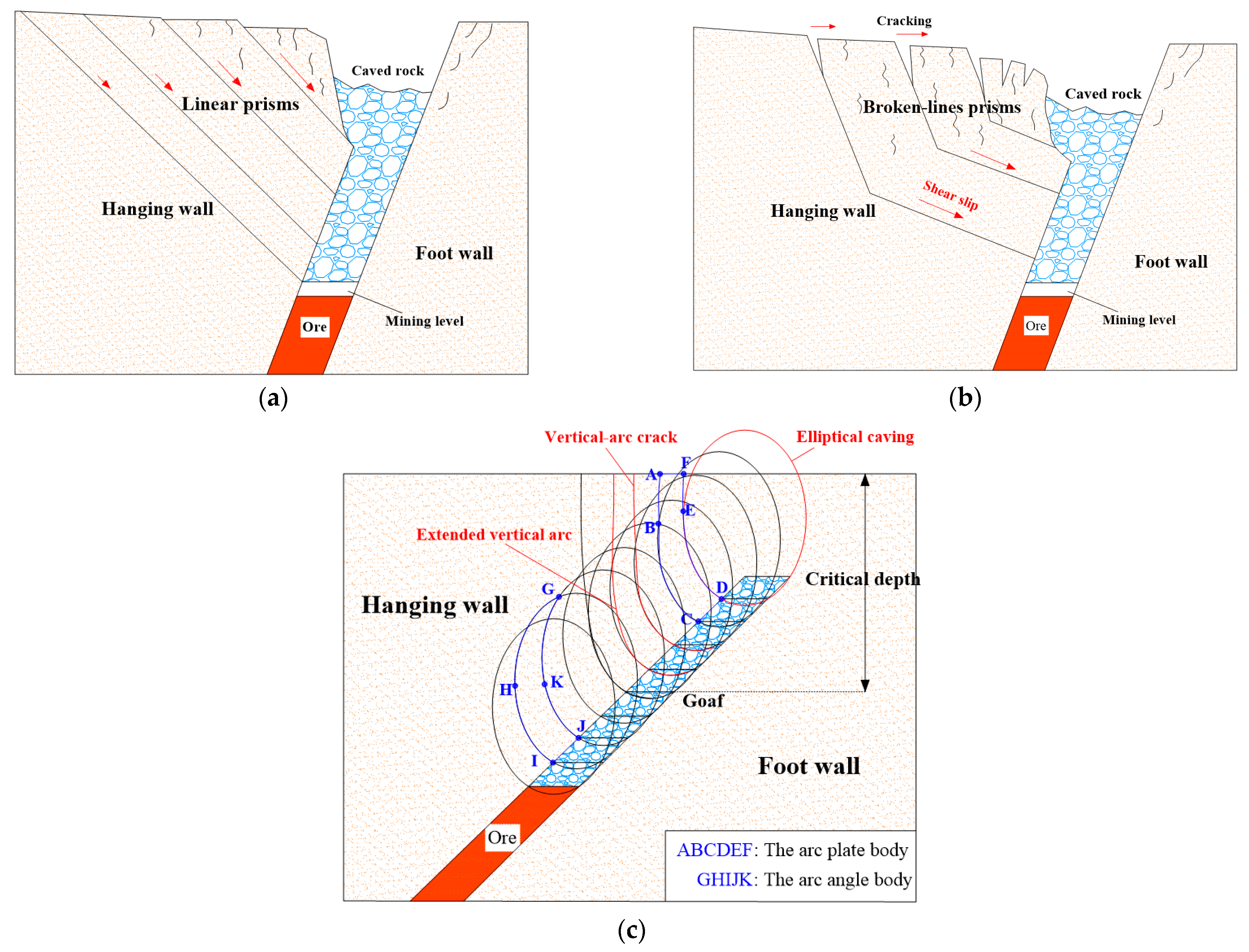
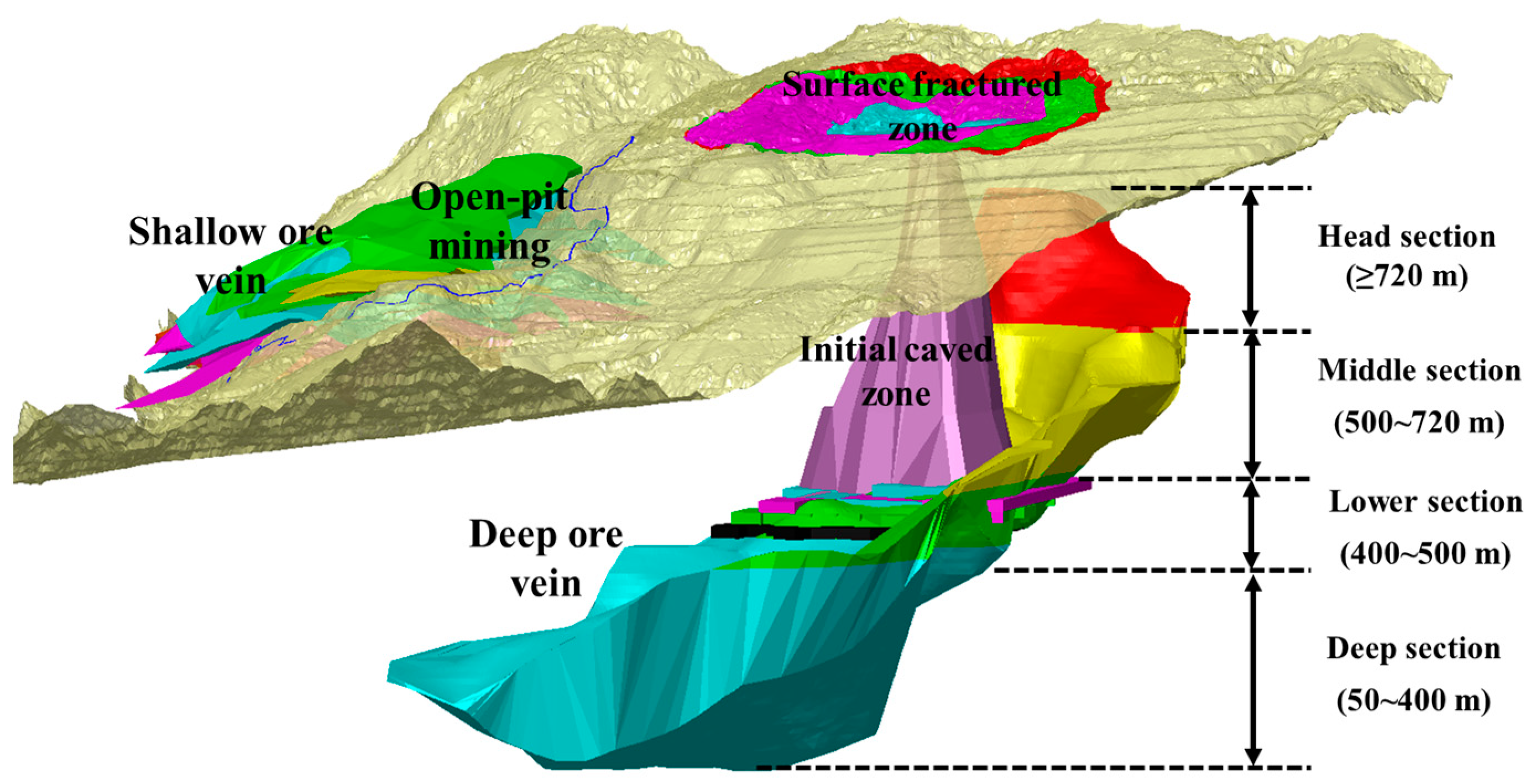
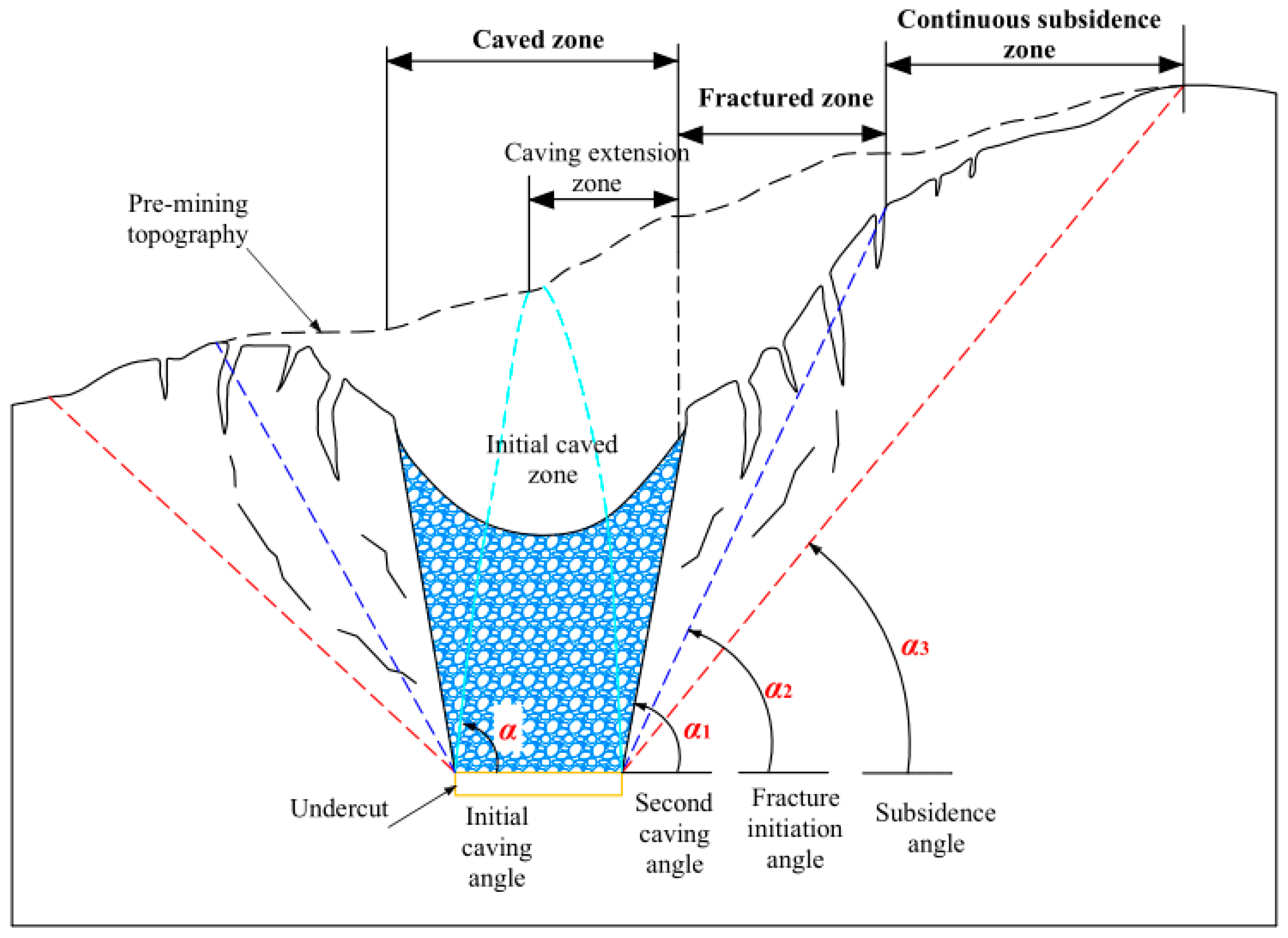

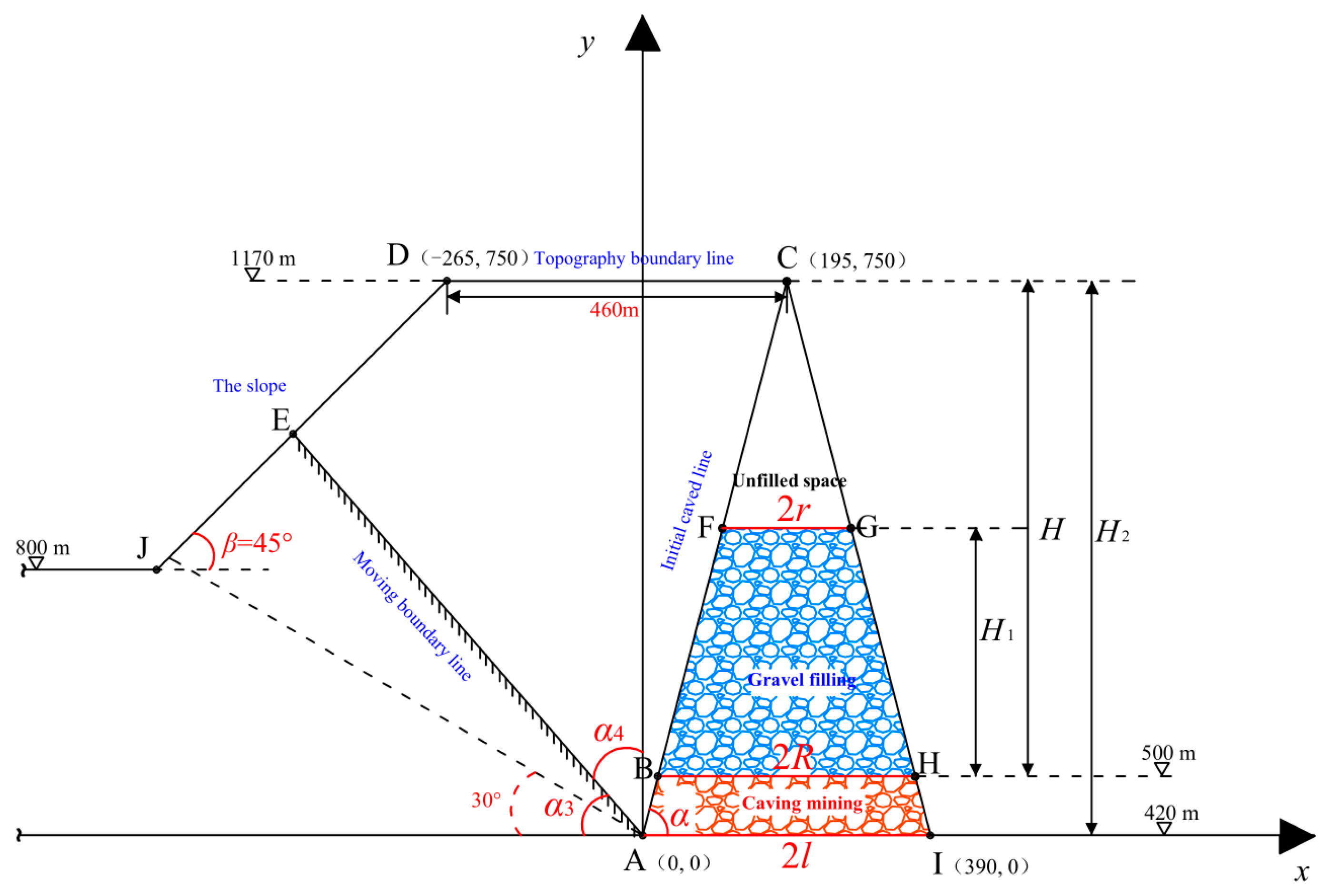
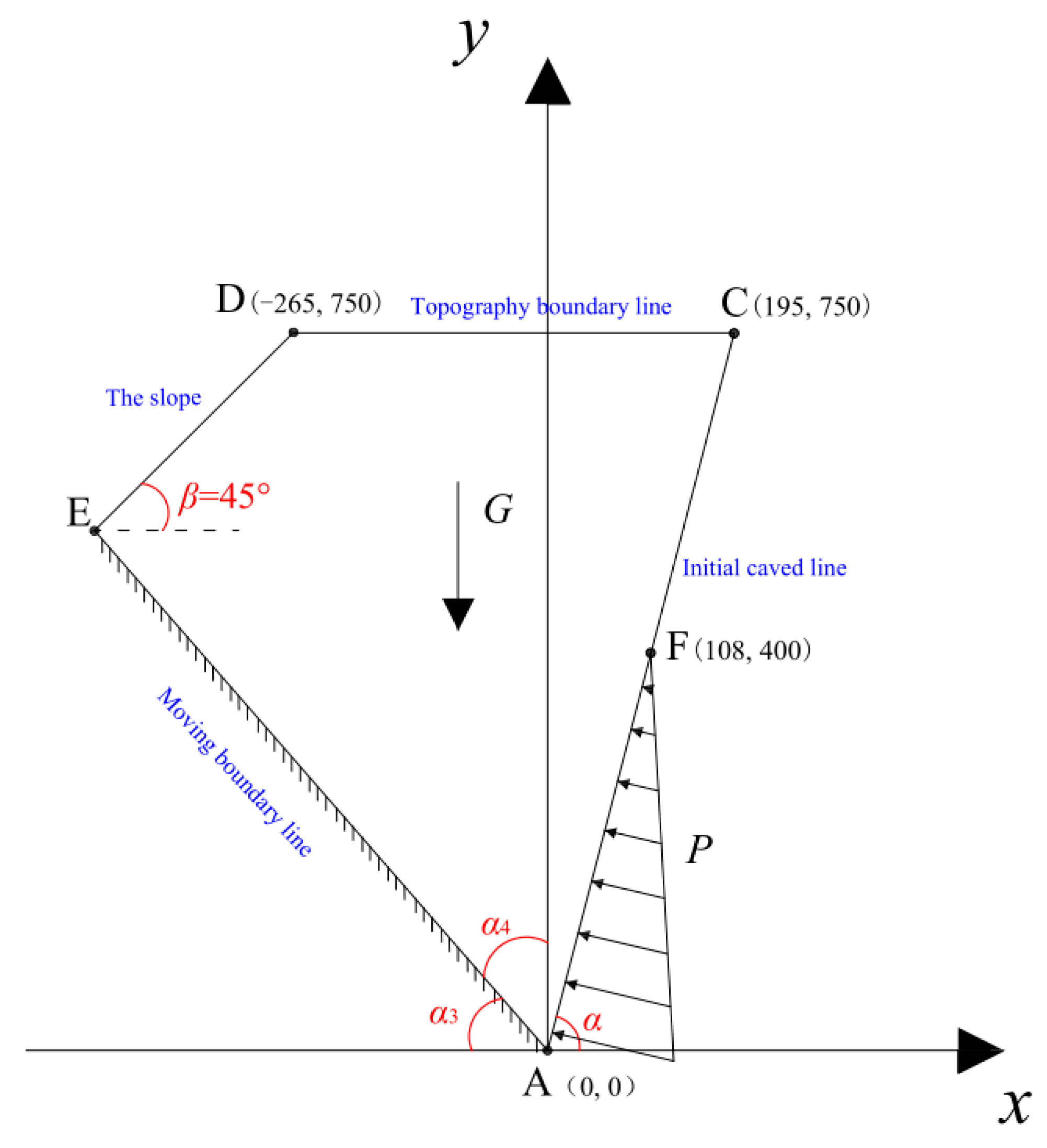

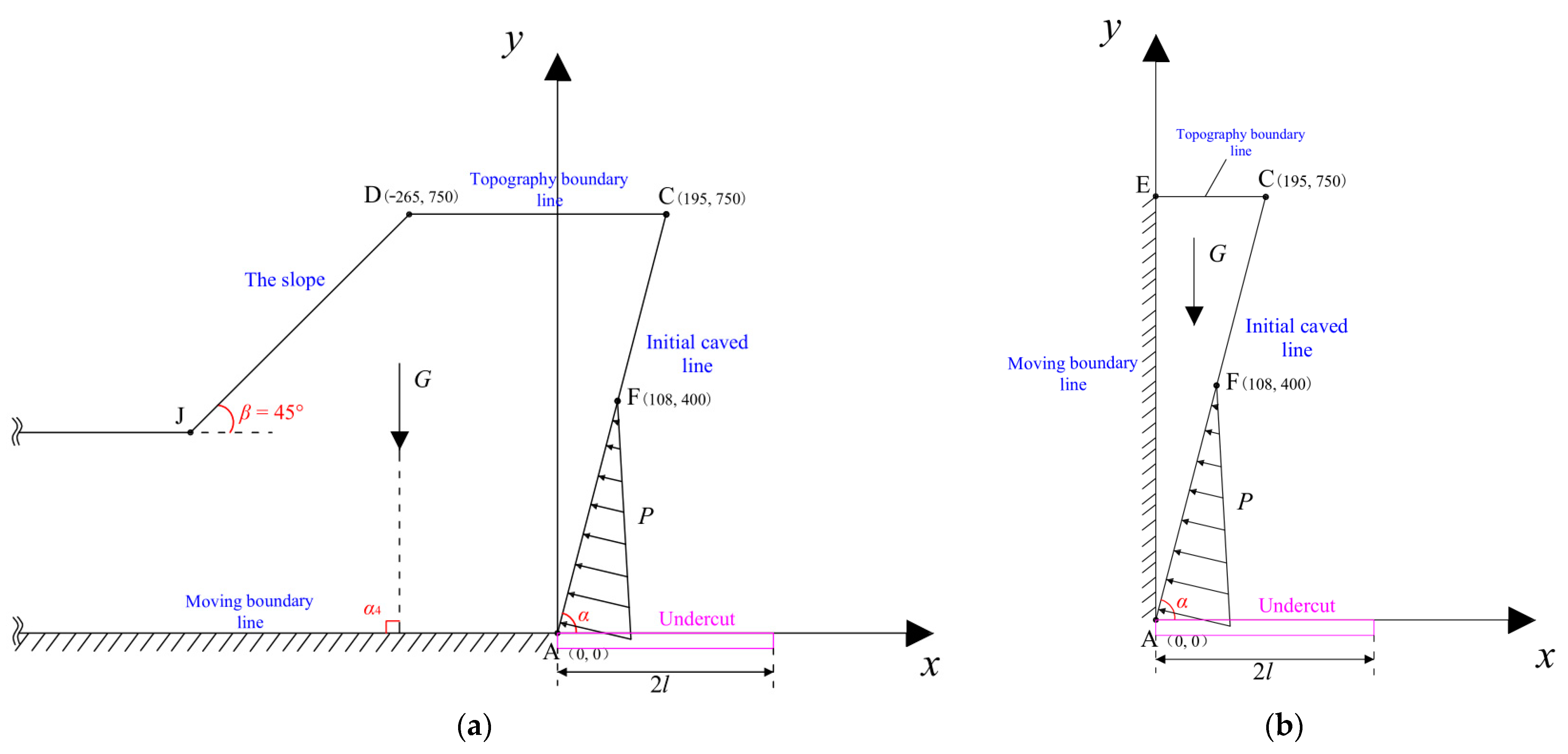
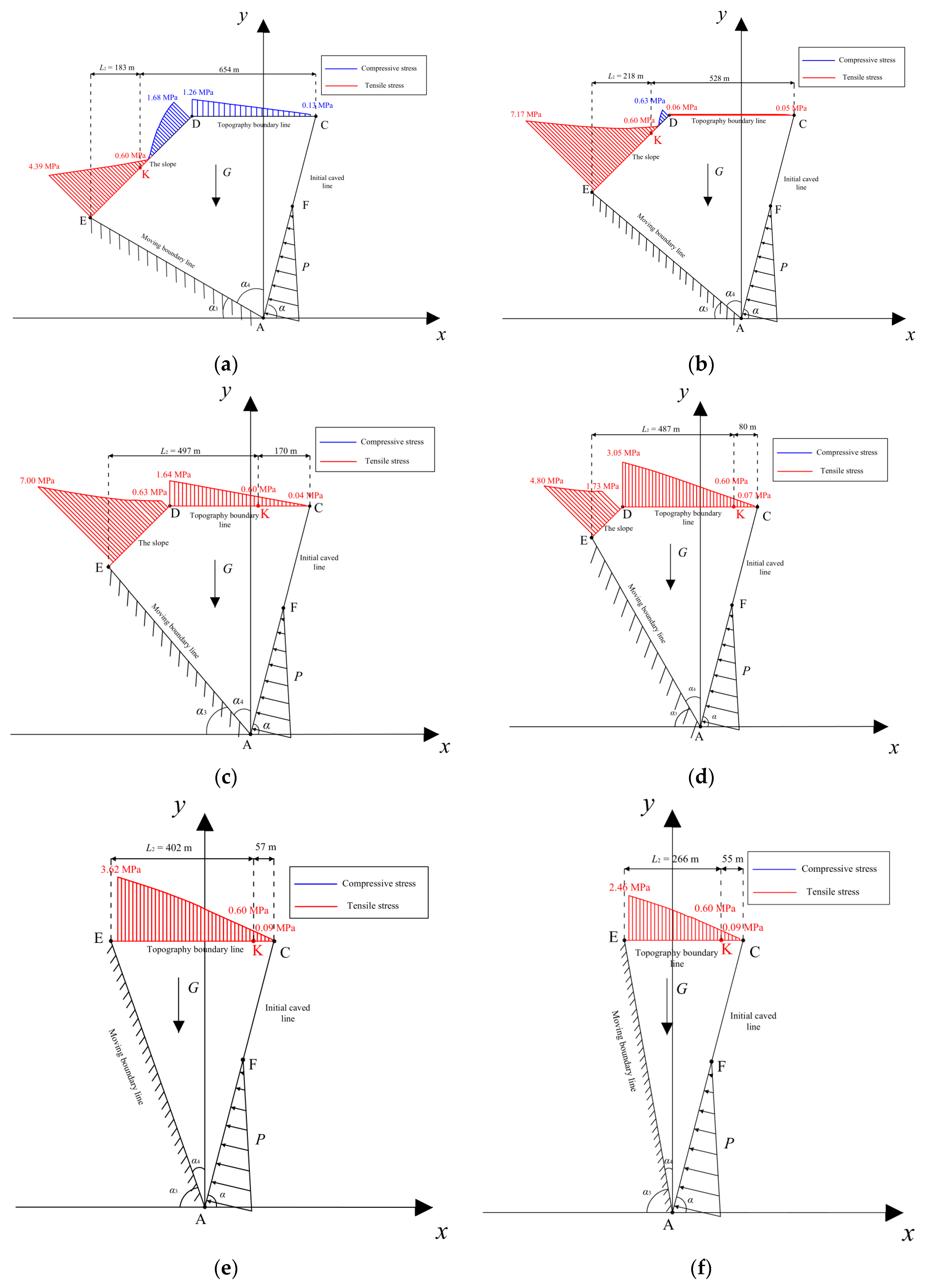
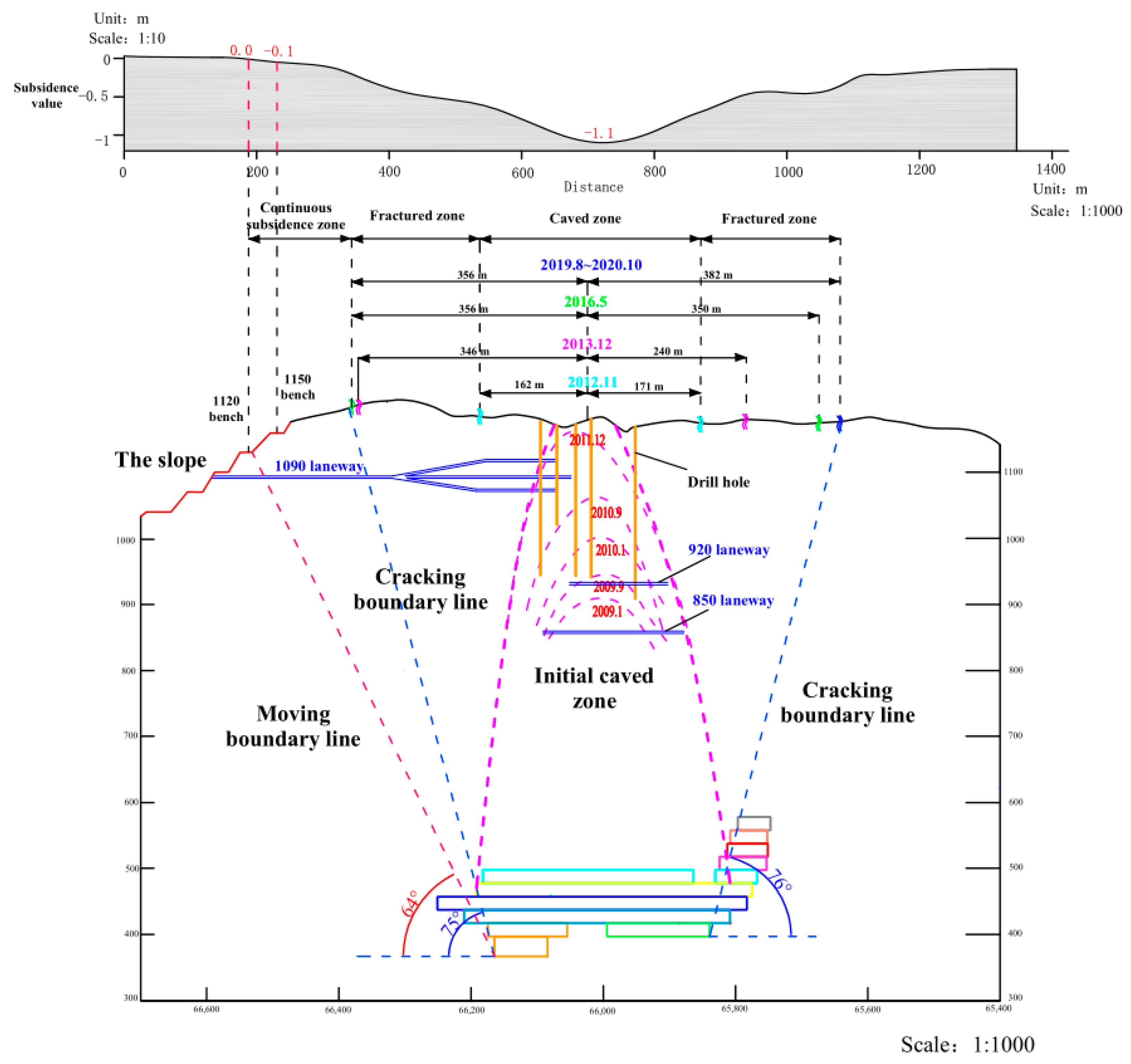

| Average Bulk Density of the Filling Gravel (γ1) | Maximum Slope Angle of the Gravel Bulk Structure (θ) | Average Bulk Density of the Surrounding Rock (γ2) | Initial Caving Angle (α) |
|---|---|---|---|
| 16.8 kN/m3 | 55° | 27.5 kN/m3 | 75° |
Disclaimer/Publisher’s Note: The statements, opinions and data contained in all publications are solely those of the individual author(s) and contributor(s) and not of MDPI and/or the editor(s). MDPI and/or the editor(s) disclaim responsibility for any injury to people or property resulting from any ideas, methods, instructions or products referred to in the content. |
© 2023 by the authors. Licensee MDPI, Basel, Switzerland. This article is an open access article distributed under the terms and conditions of the Creative Commons Attribution (CC BY) license (https://creativecommons.org/licenses/by/4.0/).
Share and Cite
Ma, K.; Yang, T.; Zhao, Y.; Gao, Y.; He, R.; Liu, Y.; Hou, J.; Li, J. Mechanical Model for Calculating Surface Movement Related to Open-Pit and Underground Caving Combined Mining. Minerals 2023, 13, 520. https://doi.org/10.3390/min13040520
Ma K, Yang T, Zhao Y, Gao Y, He R, Liu Y, Hou J, Li J. Mechanical Model for Calculating Surface Movement Related to Open-Pit and Underground Caving Combined Mining. Minerals. 2023; 13(4):520. https://doi.org/10.3390/min13040520
Chicago/Turabian StyleMa, Kai, Tianhong Yang, Yong Zhao, Yuan Gao, Rongxing He, Yilong Liu, Junxu Hou, and Jinduo Li. 2023. "Mechanical Model for Calculating Surface Movement Related to Open-Pit and Underground Caving Combined Mining" Minerals 13, no. 4: 520. https://doi.org/10.3390/min13040520
APA StyleMa, K., Yang, T., Zhao, Y., Gao, Y., He, R., Liu, Y., Hou, J., & Li, J. (2023). Mechanical Model for Calculating Surface Movement Related to Open-Pit and Underground Caving Combined Mining. Minerals, 13(4), 520. https://doi.org/10.3390/min13040520







